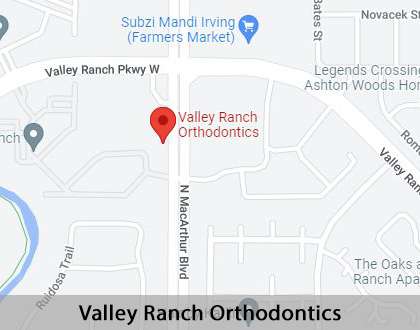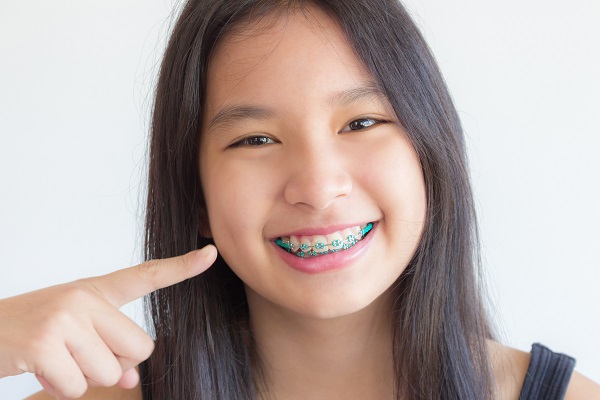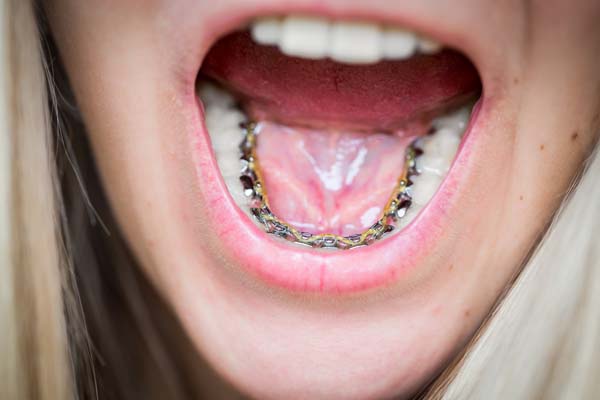Metal Braces Irving, TX
Traditional metal braces remain the most durable teeth-straightening treatment available to this day. Patients undergoing orthodontic treatment no longer have to experience the “brace-face” look as metal braces have become less bulky and more discreet through advancements in dental technology. They are also the only orthodontic appliances that allow patients to express themselves by changing the brackets’ colors every few weeks.
Metal braces are available at Valley Ranch Orthodontics in Irving and the surrounding area. We can handle your orthodontic needs to help you discover your best smile. Call us today at (972) 200-1016 to schedule an appointment or learn more about our services.
Signs a Child Needs Braces
Children may require braces for more than just aesthetic reasons. Properly-aligned teeth are essential for a healthy oral cavity and prevent many dental health problems from arising or developing further. Malocclusions, or misaligned teeth, are the greatest indicators of a child needing braces. This occurs when the top and bottom teeth or jaws do not align properly when the mouth is closed. Examples include overbites, underbites, crossbites, or open bites.
Other signs that indicate a child needs braces include:
- being prone to biting the tongue, roof of the mouth, or inside of the cheek accidentally
- breathing through the mouth
- early or late loss of baby teeth
- jaws that click or make other sounds
- teeth that are crooked or crowded
- teeth that do not come together
- thumb-sucking or using a pacifier past the age of two
In some cases, having braces treatment in childhood guides the teeth into position, requiring patients to have a second treatment round later in adolescence or adulthood.
“Malocclusions, or misaligned teeth, are the greatest indicators of a child needing braces.”
Pros and Cons of Metal Braces
The greatest disadvantage of metal braces is that they are more apparent than any other orthodontic appliance. They are also heavier on the teeth and may cause slight discomfort, especially during tightening sessions. Lastly, it is more difficult to clean both the braces and the teeth themselves, requiring patients to exercise thorough hygiene practices.
Although there may be a few disadvantages of metal braces, there are advantages as well. The benefits of traditional metal braces include their durability and effectiveness, controllability, versatility, and variety. Metal is far more durable and effective than ceramic or plastic that comes with other orthodontic appliances. These braces allow orthodontists to control tooth movement and tighten them as needed to keep treatment going as intended. Their versatile nature makes braces the only orthodontic treatment for severe or complicated cases, and variety offers patients freedom of expression.
“The benefits of traditional metal braces include their durability and effectiveness, controllability, versatility, and variety.”
The Process of Receiving Braces
The first step in receiving braces is the preliminary consultation appointment in which we will physically examine the mouth and take full X-rays. We will also take an impression using a special mold material or conduct a 3D scan to curate the individualized braces. The braces are typically ready within two to three weeks.
On the next visit, we will start by cleaning and drying out the mouth. The first step in applying the hardware is to attach a bracket, the square piece that holds the wires, to each tooth. The brackets are fixed to teeth with bonding glue and, once secured, are connected using a wire from bracket to bracket. The wires remain attached by putting small bands on top of it, and the patient can then select different colors for their bands. The entire process takes about two hours to complete.
“The first step in receiving braces is the preliminary consultation appointment in which we will physically examine the mouth and take full X-rays.”
Check out what others are saying about our orthodontic services on Yelp: Metal Braces in Irving, TX
Adjusting to Metal Braces
The first few days following treatment may cause slight discomfort and require minor adjustments. Braces work right away, and patients often experience soreness in the gums as they feel their teeth moving. We recommend patients wash their mouths frequently with warm salt water and take pain relievers to relieve initial discomfort as they become accustomed to their braces.
Patients may also need to make adjustments to their diet to protect their appliances and teeth. Avoid sticky foods such as caramels or other soft candies and hard or crunchy foods that could damage the braces, such as popcorn. Certain fruits and vegetables, including oranges, pineapple, and spinach, can get stuck in braces as well and should be cut into small pieces. We will provide the patient with a list of foods and beverages to avoid.
“Patients may also need to make adjustments to their diet to protect their appliances and teeth.”
Questions Answered on This Page
Q. What are some signs that indicate a child needs braces?
Q. What are the pros and cons of metal braces?
Q. What is the process in receiving braces?
Q. How do patients adjust to metal braces?
Q. What are the maintenance and follow-ups required with braces treatment?
People Also Ask
Q. How should I talk to my teen about getting braces?
Maintenance and Follow-Ups
To properly maintain the braces and a healthy oral cavity, it is essential to brush the braces, teeth, and gums after each meal and floss at least once daily. Food can get easily stuck between the brackets and wires, making it difficult to clean the teeth and mouth thoroughly. We will provide the patient with a special brush and floss designed specifically for braces.
Follow-up appointments are generally scheduled every four to six weeks to replace worn-out rubber bands, check progress, and make adjustments to the wires to ensure teeth are moving in the right direction. We will replace the elastic bands on each bracket during each visit and may also take out and replace the wire. Adjustment sessions typically take around 20 minutes. Missing follow-up appointments can cause a delay in the total treatment time or cause disruptions in treatment progression.
“Missing follow-up appointments can cause a delay in the total treatment time or cause disruptions in treatment progression.”
Frequently Asked Questions
Q. Do braces hurt?
A. The application of braces should not hurt. However, patients may experience some discomfort the first week as they adjust to the pressure. We will prescribe pain relief medications and highly recommend salt water rinses to alleviate any discomfort throughout treatment.
Q. What is the average duration of treatment?
A. Braces treatment can take anywhere from six months to three years, depending on the patient’s case. Factors include age, severity, and patient compliance, and adherence to specified guidelines. We will discuss each patient’s treatment time during the initial consultation appointment.
Q. Are braces bad for the teeth?
A. Braces themselves do not damage the teeth or their enamel. However, poor oral hygiene during treatment can greatly affect the teeth as tooth decay deteriorates enamel. Braces patients must work extra hard to clean their mouth and ensure they brush and floss between the braces and crevices between the teeth.
Q. Do braces move the teeth every day?
A. Braces do move the teeth every day in small increments. Patients may or may not feel this movement. The treatment duration is due to these precise but gradual adjustments.
Q. Are there any side effects of braces treatment?
A. Braces may cause some irritation, discomfort, and jaw pain. Some side effects, although rare, include tooth decay and deterioration, decalcification, allergic reactions, and root resorption. Contact us immediately or address your concerns during follow-up appointments to ensure symptoms do not worsen or affect treatment.
Quality Orthodontic Services Can Transform Smiles
By visiting us as soon as possible, our team can help get you the professional treatment you need.
Definition of Orthodontic Terminology
Find Out More
Metal braces can help you achieve the straight and healthy smile you have always wanted. Our team at Valley Ranch Orthodontics can help. Call us today at (972) 200-1016 to schedule an appointment or learn more about our services.
Helpful Related Links
- American Dental Association (ADA). Glossary of Dental Terms. 2021
About our business and website security
- Valley Ranch Orthodontics was established in 2008.
- We accept the following payment methods: Cash, Check, MasterCard, and Visa
- We serve patients from the following counties: Dallas County, Denton County, and Tarrant County
- We serve patients from the following cities: Irving, Lewisville, Addison, Dallas, Colleyville, Coppell, South Lake, Farmers Branch, Flower Mound, Carrollton, Grapevine, Las Colinas, and Highland Village
- Norton Safe Web. View Details
- Trend Micro Site Safety Center. View Details
Back to top of Metal Braces







